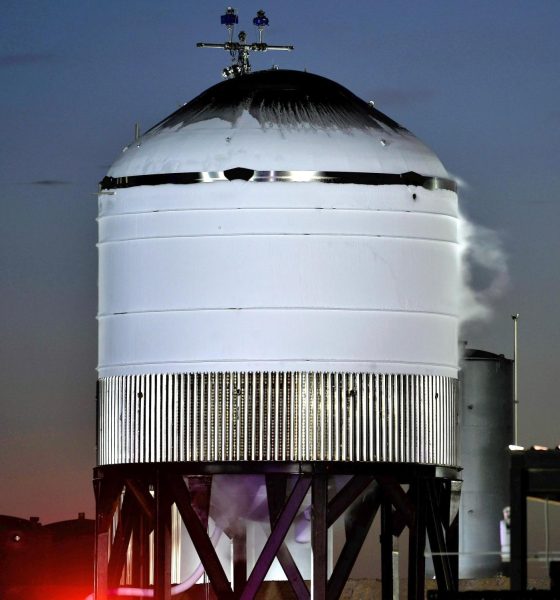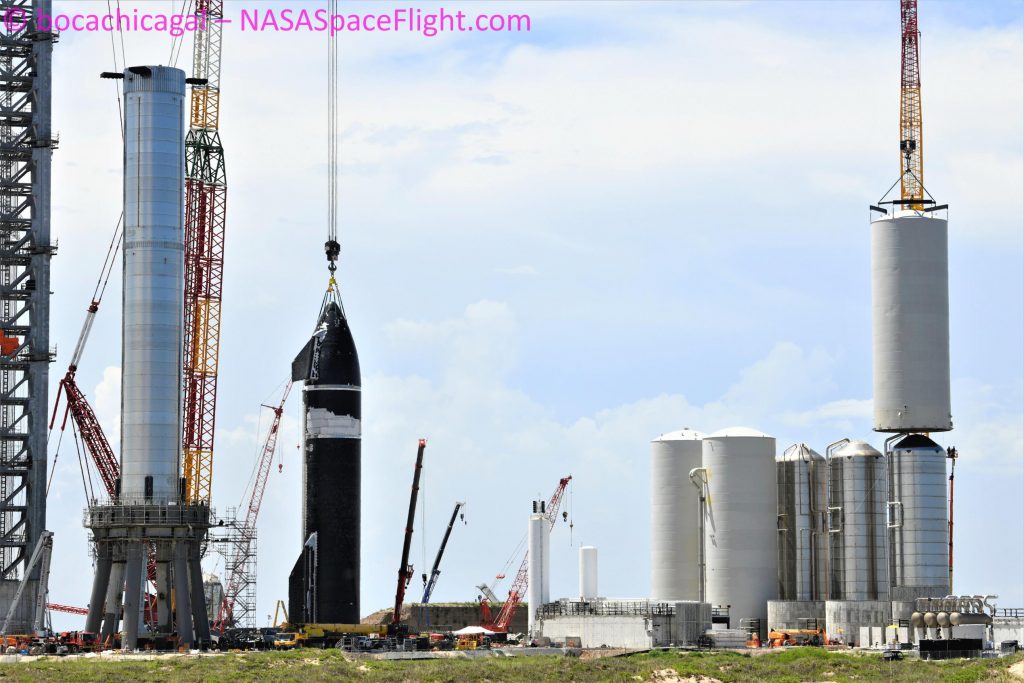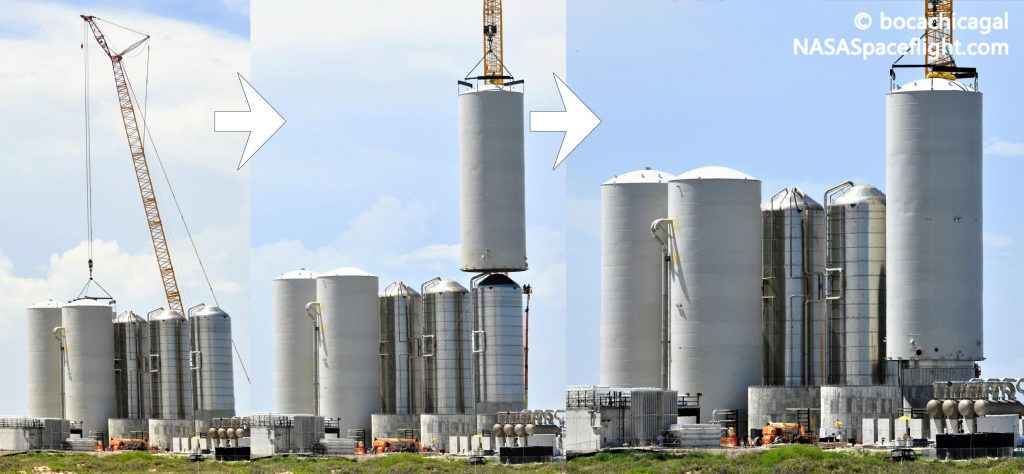

News
SpaceX’s odd Starbase propellant storage tank prototype passes first test
Likely to the relief of many, SpaceX appears to have successfully tested a prototype of the custom-built Starbase propellant storage tanks that will eventually hold thousands of tons of fuel and oxidizer.
For reasons unknown, SpaceX’s built its first ground support equipment (GSE) ‘test tank’ – a subscale prototype designed to quickly verify basic production quality and design goals – months after it began mass-producing operational storage tanks. In fact, of the seven total GSE tanks expected to be built, SpaceX has already completed seven, installed five, and scrapped one. Known as GSE4, SpaceX actually used modified parts of that scrapped tank to assemble the GSE test tank that first rolled to Starbase’s launch (and test) facilities on August 23rd.
Two days later, SpaceX subjected the small tank to its first test.
Given that SpaceX appears to have almost retroactively assembled the GSE4 test tank after building the final products, the results from its testing were always going to be significantly more anxiety-inducing than any of the more than half-dozen other tanks the company has tested in the last year and a half. Having already fabricated, assembled, or even installed six of seven planned GSE tanks, the discovery of major issues during testing could potentially cause months of delays by forcing SpaceX to perform lengthy repairs or even fully scrap all six existing tanks and start over.

Thankfully, at least for the time being, it appears that SpaceX can write off those potential worst-case scenarios. On August 25th, SpaceX took advantage of a test window initially believed to be for Starship S20 and put the cobbled-together GSE4 tank through its paces for the first time. As with previous test tanks, all SpaceX can really do is fill the prototype with liquid nitrogen (LN2), a non-flammable alternative to liquid oxygen or methane propellant that is approximately as cold and heavy. As a storage tank prototype, though, GSE4 has no need for hydraulic ram setups used to simulate the thrust of Raptor engines on several previous prototypes.
As such, one or several cryogenic proof tests were all that were ever really in GSE4’s future. On GSE4’s first test, SpaceX performed a more or less normal cryogenic proof, completely filling the tank with LN2, closing its vents, and then allowing the natural process of LN2 boiloff to raise the tank to the desired test pressure. However, unlike other test tanks, GSE4 never actually appeared to reopen its main vents. In fact, SpaceX may have never actually drained liquid nitrogen from the test tank, instead simply letting it slowly warm up and boil off into gas that was seemingly managed and vented by ground systems instead of the tank itself.
As a result, GSE4 stayed frosty (indicating a significant amount of remaining liquid nitrogen) for more than eight hours, strongly implying that it was either very slowly drained or simply allowed to warm up naturally. Given that large cryogenic storage tanks really don’t have to be significantly pressurized to complete their job, it’s possible that GSE4’s first test was primarily meant to verify the basic structural integrity of a tank that’s slightly different than those on Starship and, more importantly, test a different method of pressure and fluid management where most of that work is done by external, permanent systems on the ground.
That’s exactly what one might expect of rocket tankage slightly modified to serve as ground storage tanks. SpaceX’s GSE tanks never have to act as self-contained units and can instead rely almost entirely on separate systems.

Aside from verifying that that slightly different method of tank operations works as expected, GSE4’s first test likely also allowed SpaceX to better characterize the thermal properties of the thin steel skin and domes that are Starship and GSE tanks. Unlike GSE4, operational GSE tanks will be enclosed inside 12m (~40 ft) wide ‘cryo shells’ designed to insulate their cryogenic contents, but the insulative properties of the inner tanks (or the lack there of, rather) will still determine how well that insulation works and how much is actually needed to reach the desired boiloff rates. A contractor hired by SpaceX has already completed all seven cryo shells, so any results gathered from GSE4 will obviously be more of a check than a developmental test, but data is still data.

News
NVIDIA Director of Robotics: Tesla FSD v14 is the first AI to pass the “Physical Turing Test”
After testing FSD v14, Fan stated that his experience with FSD felt magical at first, but it soon started to feel like a routine.

NVIDIA Director of Robotics Jim Fan has praised Tesla’s Full Self-Driving (Supervised) v14 as the first AI to pass what he described as a “Physical Turing Test.”
After testing FSD v14, Fan stated that his experience with FSD felt magical at first, but it soon started to feel like a routine. And just like smartphones today, removing it now would “actively hurt.”
Jim Fan’s hands-on FSD v14 impressions
Fan, a leading researcher in embodied AI who is currently solving Physical AI at NVIDIA and spearheading the company’s Project GR00T initiative, noted that he actually was late to the Tesla game. He was, however, one of the first to try out FSD v14.
“I was very late to own a Tesla but among the earliest to try out FSD v14. It’s perhaps the first time I experience an AI that passes the Physical Turing Test: after a long day at work, you press a button, lay back, and couldn’t tell if a neural net or a human drove you home,” Fan wrote in a post on X.
Fan added: “Despite knowing exactly how robot learning works, I still find it magical watching the steering wheel turn by itself. First it feels surreal, next it becomes routine. Then, like the smartphone, taking it away actively hurts. This is how humanity gets rewired and glued to god-like technologies.”
The Physical Turing Test
The original Turing Test was conceived by Alan Turing in 1950, and it was aimed at determining if a machine could exhibit behavior that is equivalent to or indistinguishable from a human. By focusing on text-based conversations, the original Turing Test set a high bar for natural language processing and machine learning.
This test has been passed by today’s large language models. However, the capability to converse in a humanlike manner is a completely different challenge from performing real-world problem-solving or physical interactions. Thus, Fan introduced the Physical Turing Test, which challenges AI systems to demonstrate intelligence through physical actions.
Based on Fan’s comments, Tesla has demonstrated these intelligent physical actions with FSD v14. Elon Musk agreed with the NVIDIA executive, stating in a post on X that with FSD v14, “you can sense the sentience maturing.” Musk also praised Tesla AI, calling it the best “real-world AI” today.
News
Tesla AI team burns the Christmas midnight oil by releasing FSD v14.2.2.1
The update was released just a day after FSD v14.2.2 started rolling out to customers.

Tesla is burning the midnight oil this Christmas, with the Tesla AI team quietly rolling out Full Self-Driving (Supervised) v14.2.2.1 just a day after FSD v14.2.2 started rolling out to customers.
Tesla owner shares insights on FSD v14.2.2.1
Longtime Tesla owner and FSD tester @BLKMDL3 shared some insights following several drives with FSD v14.2.2.1 in rainy Los Angeles conditions with standing water and faded lane lines. He reported zero steering hesitation or stutter, confident lane changes, and maneuvers executed with precision that evoked the performance of Tesla’s driverless Robotaxis in Austin.
Parking performance impressed, with most spots nailed perfectly, including tight, sharp turns, in single attempts without shaky steering. One minor offset happened only due to another vehicle that was parked over the line, which FSD accommodated by a few extra inches. In rain that typically erases road markings, FSD visualized lanes and turn lines better than humans, positioning itself flawlessly when entering new streets as well.
“Took it up a dark, wet, and twisty canyon road up and down the hill tonight and it went very well as to be expected. Stayed centered in the lane, kept speed well and gives a confidence inspiring steering feel where it handles these curvy roads better than the majority of human drivers,” the Tesla owner wrote in a post on X.
Tesla’s FSD v14.2.2 update
Just a day before FSD v14.2.2.1’s release, Tesla rolled out FSD v14.2.2, which was focused on smoother real-world performance, better obstacle awareness, and precise end-of-trip routing. According to the update’s release notes, FSD v14.2.2 upgrades the vision encoder neural network with higher resolution features, enhancing detection of emergency vehicles, road obstacles, and human gestures.
New Arrival Options also allowed users to select preferred drop-off styles, such as Parking Lot, Street, Driveway, Parking Garage, or Curbside, with the navigation pin automatically adjusting to the ideal spot. Other refinements include pulling over for emergency vehicles, real-time vision-based detours for blocked roads, improved gate and debris handling, and Speed Profiles for customized driving styles.
Elon Musk
Elon Musk’s Grok records lowest hallucination rate in AI reliability study
Grok achieved an 8% hallucination rate, 4.5 customer rating, 3.5 consistency, and 0.07% downtime, resulting in an overall risk score of just 6.

A December 2025 study by casino games aggregator Relum has identified Elon Musk’s Grok as one of the most reliable AI chatbots for workplace use, boasting the lowest hallucination rate at just 8% among the 10 major models tested.
In comparison, market leader ChatGPT registered one of the highest hallucination rates at 35%, just behind Google’s Gemini, which registered a high hallucination rate of 38%. The findings highlight Grok’s factual prowess despite the AI model’s lower market visibility.
Grok tops hallucination metric
The research evaluated chatbots on hallucination rate, customer ratings, response consistency, and downtime rate. The chatbots were then assigned a reliability risk score from 0 to 99, with higher scores indicating bigger problems.
Grok achieved an 8% hallucination rate, 4.5 customer rating, 3.5 consistency, and 0.07% downtime, resulting in an overall risk score of just 6. DeepSeek followed closely with 14% hallucinations and zero downtime for a stellar risk score of 4. ChatGPT’s high hallucination and downtime rates gave it the top risk score of 99, followed by Claude and Meta AI, which earned reliability risk scores of 75 and 70, respectively.

Why low hallucinations matter
Relum Chief Product Officer Razvan-Lucian Haiduc shared his thoughts about the study’s findings. “About 65% of US companies now use AI chatbots in their daily work, and nearly 45% of employees admit they’ve shared sensitive company information with these tools. These numbers show well how important chatbots have become in everyday work.
“Dependence on AI tools will likely increase even more, so companies should choose their chatbots based on how reliable and fit they are for their specific business needs. A chatbot that everyone uses isn’t necessarily the one that works best for your industry or gives accurate answers for your tasks.”
In a way, the study reveals a notable gap between AI chatbots’ popularity and performance, with Grok’s low hallucination rate positioning it as a strong choice for accuracy-critical applications. This was despite the fact that Grok is not used as much by users, at least compared to more mainstream AI applications such as ChatGPT.








